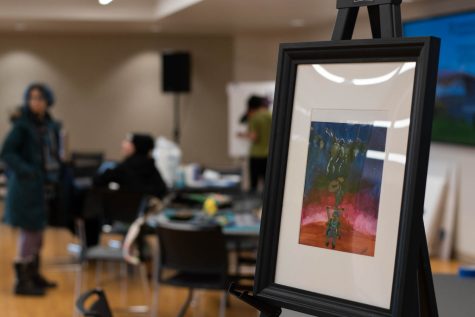The puff-puff: a Nigerian delicacy
November 6, 2014
Students learned how to create a puff last night. That is, a puff-puff, a traditional Nigerian delicacy, which is essentially a fried yeast ball served popularly in many variations around the globe. During a Nigerian cooking demonstration that took place on last night, Nigerian international student Tosin Adelaje demonstrated how to make the snack.
In Nigeria, Adelaje said her mother’s friend taught her how to make puff-puff when she was 16.
In Nigeria, puff-puff is a must whether preparing food for a small or large gathering. Adelaje said when she invites people to parties, one invitation is for three people. One hundred people is the minimum of people at a traditional African party where she serves puff-puff, she said. Back home in Nigeria, she’d prepare puff-puff for more than 100 guests.
Puff-puff can be served with any type of meal and can be served as both an appetizer and a desert. Many subtle variations can be made to puff-puffs, such as adding coconut flakes, spices and peanuts.
But, puff-puffs are also easy to prepare.
The recipe involves 3 ½ cups of flower, ½ cup of sugar (or more, depending on desired level of sweetness), ½ teaspoon of nutmeg and salt, as well as one packet of yeast.
To begin, Adelaje gently poured the flower, sugar and teaspoon of nutmeg and salt into a bowl, along with a packet of yeast. She then mixed the ingredients with 2 cups of warm water until it becomes dough.
Instead of mixing the dough with a spoon, she used her hands.
“In Africa we like using hand,” she said.
After the dough is fully leavened, she covered the bowl with a wrap and let it sit for 45 minutes.
Once the bubbles begin to rise in the dough, it is ready to fry.
Gently, she scooped sections of dough and tossed it into a pot, half full of oil. The audience, who mainly consisted of international students, watched as Adelaje taught them how to fry the puff-puff.
As the puff-puff becomes a light brown, they are scooped and set on a plate to cool off.
As they slowly cool down, everyone begins to consume the traditional delicacy of Nigeria.
Food is very significant when understanding culture because each culture has its own tradition and that is the goal of the International Center at WSU, said Kate Hellman, associate director of the center.
The International Center matches American students with international students to have a unique and cultural experience at Pullman. The center also gives people an opportunity to learn about different countries and culture. Adelaje is one of the many international students who shared a special dish from her culture. Cooking is an important part of understanding culture because, Hellman said.
“People come together around food,” she said.
Food is an essential part of culture because it’s generational, and it comes from a history of ancestors who pass recipes down from generation to generation, said audience member and international student Sharifah Altahi an English language student from Saudi Arabia.
Many cultural events take place in the International Center, where students can culturally immerse themselves without having to travel outside of campus, through the sharing of food and conversation.




















